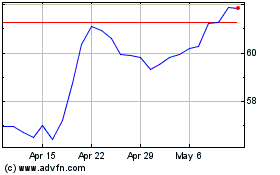Wells Fargo's New Chairman Elizabeth Duke Knows Crises -- Update
August 15 2017 - 9:59PM
Dow Jones News
By Emily Glazer
This isn't the first banking crisis Elizabeth Duke has
faced.
Ms. Duke, who was named incoming independent chairman of Wells
Fargo & Co. on Tuesday, will help oversee the bank as it is
struggles with several scandals across its businesses. She will
start her new job Jan. 1.
She had a similar start to her role as Federal Reserve governor
in August 2008, as the financial crisis was enveloping the country.
She served in the role at the central bank through August 2013.
"There was no way that I, or anyone else, could have foreseen
the tumultuous events that were about to unfold," she said in a
February 2011 speech. About a year later, during another speech,
she said: "I witnessed firsthand the damage that can result from
reckless lending and weak risk-management practices."
That echoes some of the problems facing Wells Fargo, about a
year after its sales-practices scandal emerged and weeks after
reports of new problems in its consumer-lending unit around
auto-related products.
Ms. Duke said in an interview she wasn't seeking the chairman
role since she planned to lower the stress after her time at the
Fed. But she acknowledged that for Wells Fargo, "it is time to
change into another gear" and she has experience to help the bank
do that.
Ms. Duke will lead the board even as Wells Fargo shareholders
have said they are wary of directors' role, with nine directors
receiving less than 75% approval for reelection at the bank's
annual meeting in April. Ms. Duke received 75%. Generally,
directors receive support of 95% or more.
The onetime Fed governor first made a name for herself as a
community banker, then as a lobbyist -- the first female to run the
American Bankers Association and the Virginia Bankers Association.
She also served on the board of directors of the Federal Reserve
Bank of Richmond.
At the Fed, she was known for acknowledging the regulatory
burden for smaller banks and speaking publicly that they shouldn't
be treated equal to larger firms, said Peter Conti-Brown, a Fed
historian and assistant professor at The Wharton School of the
University of Pennsylvania.
Ms. Duke once said in a speech that she "chose a career in
banking for one simple reason: I needed a job." Ms. Duke began as a
part-time drive-through teller, after studying drama at the
University of North Carolina at Chapel Hill. She planned to be an
actress but put it aside given the necessity of getting a job.
She later snagged a full-time job at a startup bank with 11
employees whose president became her mentor. He died suddenly of a
heart attack and Ms. Duke took his place as chief executive of
Virginia-based Bank of Tidewater during the savings and loan
crisis. That bank was ultimately acquired by Wachovia Corp., where
she worked briefly before its merger with Wells Fargo during the
financial crisis.
Much of her focus as a community banker was lending to small
businesses, something Ms. Duke has reiterated throughout her career
as a lobbyist and later as a Fed governor. "I fully expected to
complete my career working as a community banker in my hometown,"
she said in the February 2011 speech.
Now, though, she's focused at the task at hand. Ms. Duke said
her role as chair will be on rebuilding the trust between the board
and management, getting the board back to a "strategic level" and
ensuring "a confidence level" that management is going to do their
jobs.
Mary Jo White, former chairman of the Securities and Exchange
Commission, who advised Wells Fargo's board on its recent changes,
said when she advises boards, especially highly-regulated entities
like banks, there is the need for a mix of expertise such as
financial regulation, banking, public company CEOs and accounting.
And Ms. Duke certainly brings deep regulatory experience, said Ms.
White, now a senior partner at Debevoise & Plimpton LLP.
Ms. Duke said Wells Fargo CEO Timothy Sloan and his management
team appropriately handled the most recent issues around
auto-related products the bank is dealing with since it
self-identified the problems through its enhanced risk management,
stopped the practices, changed leadership, restructured the
business, investigated the size and scope of remediation, and kept
the board and regulators informed.
"If you're going to really look through and try to improve your
business practices, you're going to find problems in a company of
this size and this complexity," she said. "It's how you deal with
those--that is really telling to me."
Write to Emily Glazer at emily.glazer@wsj.com
(END) Dow Jones Newswires
August 15, 2017 21:44 ET (01:44 GMT)
Copyright (c) 2017 Dow Jones & Company, Inc.
Wells Fargo (NYSE:WFC)
Historical Stock Chart
From Mar 2024 to Apr 2024

Wells Fargo (NYSE:WFC)
Historical Stock Chart
From Apr 2023 to Apr 2024
